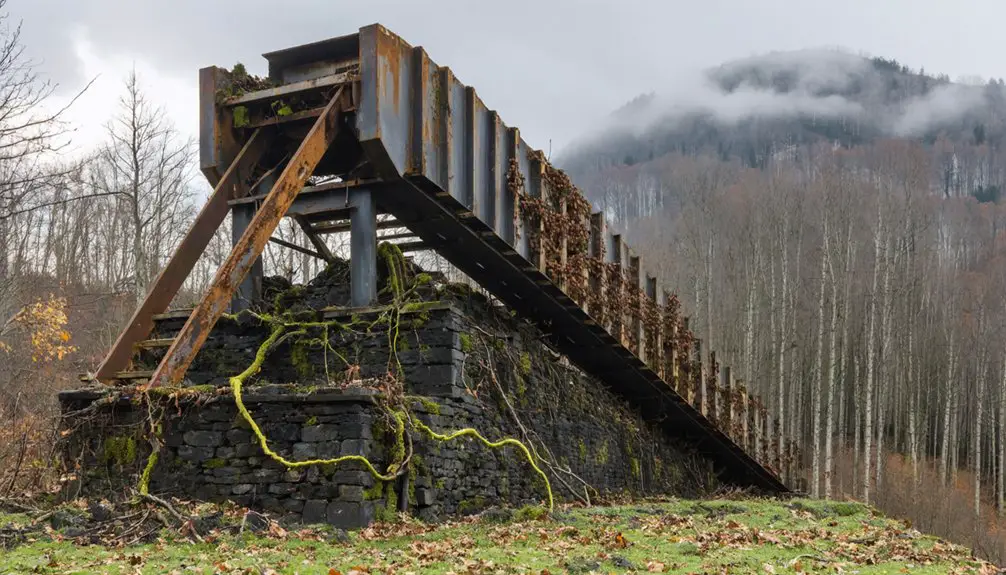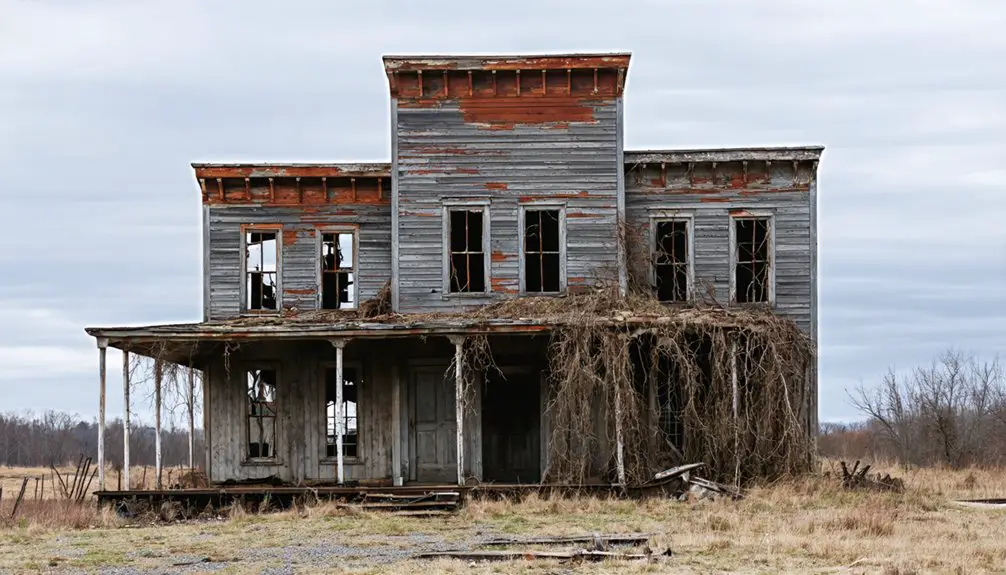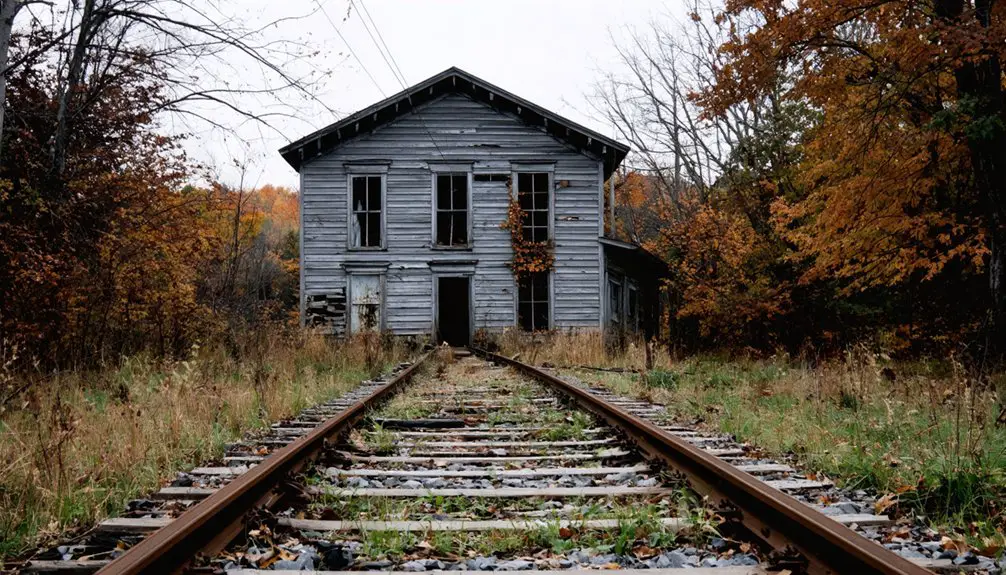You’ll find Ardara’s ghost town remnants in Pennsylvania, where it once thrived as a glass sand mining community rather than a coal town. The area’s pure white sand deposits supported industrial glassmaking operations from the post-Civil War era until environmental disaster struck. In 1962, a city-sanctioned trash fire sparked underground fires, forcing residents to abandon their homes. Today, smoke still seeps through the ground where this unique mining settlement once stood, holding untold stories beneath its scarred surface.
Key Takeaways
- Ardara was a glass sand mining town in Pennsylvania that operated from the post-Civil War era until its eventual abandonment.
- A devastating trash fire in 1962 ignited underground fires, releasing toxic fumes and creating dangerous sinkholes throughout the community.
- The population declined from 1,200 residents as government buyouts in the 1980s and 1992 forced people to relocate.
- The town’s remaining structures stand abandoned, with smoke still seeping from the ground due to ongoing underground fires.
- Ardara’s legacy includes its unique glass sand mining history and the cultural heritage of Eastern and Southern European immigrant miners.
The Rise of a Mining Community

While Pennsylvania’s bituminous coalfields dominated the region’s mining narrative, Ardara carved out its own unique industrial identity through the extraction of premium glass sand.
Beyond coal country’s shadow, Ardara made its mark mining the nation’s finest glass sand, forging a distinct industrial legacy.
During a time when room-and-pillar mines were developing throughout Pennsylvania’s coal regions, Ardara took a different path in resource extraction. The tunnels featured cathedral-like structures that provided natural support without traditional shoring materials.
You’ll find Ardara’s origins traced to the post-Civil War era when prospectors discovered deposits of exceptionally pure white sand in the surrounding hills. This wasn’t just any sand – it was the finest glass sand in the country, an essential component for industrial glassmaking.
The mining operation, though modest with about 20 workers, transformed the landscape with its innovative blend of strip mining and tunneling methods. Workers hauled sand from tunnels using wheelbarrows, then cleaned it in steam-driven facilities before shipping it downriver to enthusiastic glass manufacturers.
The community’s growth paralleled the expansion of America’s glass industry, establishing Ardara as a significant link in regional manufacturing.
Life in Coal Country
As you stand in what remains of Ardara’s coal-dusted streets, you’ll find echoes of a life where mining families rose before dawn, fathers and sons descending into the earth while mothers maintained crowded company houses and prepared meals for their return.
Sprags and switches helped control the movement of coal cars on steep mine inclines, with spraggers playing a vital role in preventing runaway accidents. Your ancestors built powerful support networks through ethnic social clubs, mutual aid societies, and faith communities that helped families survive accidents, wage cuts, and harsh working conditions. The War of 1812 sparked increased demand for anthracite coal when British naval blockades disrupted coastal fuel shipments.
Underground, miners developed their own culture and traditions, from sharing food during brief breaks to teaching secret warning signals that could mean the difference between life and death.
Daily Mining Family Routine
During the peak of coal mining in Ardara, families structured their entire lives around the demanding 10-12 hour underground shifts that began before dawn.
You’d find the men trudging off to the mines while women prepared hearty, high-carb meals and maintained the modest company houses.
Family dynamics revolved around strict gender roles, with daily rituals reflecting the heritage of Irish, Welsh, and Eastern European immigrants who called these cramped coal town streets home.
Your family’s survival depended on everyone contributing – children sorted coal as breaker boys or helped with household chores when they weren’t in school.
You’d live in constant awareness of mining hazards, knowing that accidents or illness could instantly disrupt your family’s routine and economic stability. The room and pillar method was the primary way miners extracted coal, requiring intense physical labor in dangerous conditions.
Despite harsh conditions, you’d find strength in the tight-knit community that shared your struggles. Many workers were lower-wage immigrants who arrived from central and southern Europe, creating a diverse cultural fabric in mining communities.
Community Support Networks
Life beyond the coal mines depended on intricate support networks that bound Ardara’s residents together. You’d find mutual aid societies ready to help during times of illness or injury, while cooperative stores offered relief from company store exploitation. Immigrant communities shaped the social fabric through their shared hardships and determination.
Ethnic groups, including Polish, Irish, and Italian families, maintained vibrant cultural preservation through social clubs and parish activities. Your neighbors would pitch in to watch children during long mining shifts, with older siblings taking on significant responsibilities. The community carefully documented accident and compensation details to ensure families received proper benefits when tragedy struck.
Local churches served as community hubs, organizing both spiritual gatherings and material support for struggling families. When mines began closing, community resilience shone through as residents established retraining programs and job networks.
Despite economic hardship, you’d witness remarkable solidarity through burial clubs, informal lending circles, and educational initiatives that gave mining families hope for a better future.
Underground Culture and Traditions
Deep beneath Ardara’s surface, miners forged a distinct underground culture built on survival, solidarity, and shared wisdom.
You’d find an intricate system of communication developed by necessity – hand signals cutting through the deafening machinery noise, whistle codes warning of danger, and unspoken understandings between mining buddies who protected each other’s lives.
Underground rituals and miner superstitions played an essential role in daily survival. You might’ve carried lucky charms, recited protective prayers before descending, or followed time-honored customs passed down through generations. Before coke replaced charcoal, miners relied heavily on traditional methods passed through generations of workers. The diverse mix of central European immigrants brought their own unique customs and beliefs to the mining community.
Through songs and chants echoing in dim-lit tunnels, miners preserved their heritage and lifted spirits during grueling shifts. This rich culture, shaped by diverse European traditions, created an unshakeable bond among those who shared the dangerous world beneath Ardara’s soil.
Mining Operations and Economic Impact
You’ll find that Ardara’s coal extraction relied heavily on underground room-and-pillar methods, with miners using manual techniques to extract bituminous coal from hillside tunnels and transport it via wheelbarrows.
The local workforce numbered in the hundreds during peak operations, providing essential labor for both the mines and the two batteries of brick block ovens that processed coal into coke.
The coke production directly supported western Pennsylvania’s expanding steel industry, creating a crucial economic link between Ardara’s mining operations and the region’s industrial growth, particularly in railroads and shipbuilding.
Coal Production Methods
While western Pennsylvania’s coal industry evolved over centuries, Ardara’s mining operations exemplified the region’s typical extraction methods from the late 1700s through the early 20th century.
You’ll find both drift mining and shaft mining were prominent, with miners initially relying on picks, shovels, and timber supports to extract the valuable bituminous coal.
- Room-and-pillar mining dominated the landscape, leaving strategic columns of coal to prevent roof collapse.
- Transport systems progressed from basic mule-drawn carts to sophisticated railroad networks.
- Underground tunnels connected through portals and company trestles, allowing efficient movement of coal to nearby iron works.
The industry’s advancement didn’t stop there – you’d eventually see the introduction of electric lamps replacing dangerous open flames, and mechanized extraction methods improving efficiency while maintaining the region’s mining heritage.
Workforce and Employment Numbers
The coal mining industry’s workforce in Pennsylvania reached its modern peak in 2012 with 8,927 employees before declining to 4,825 workers by 2023, reflecting broader changes that shaped Ardara’s eventual transformation into a ghost town.
You’ll find that employment trends in the region showed approximately 70% of miners worked underground, while the remainder operated surface facilities and support roles.
The industry’s impact extended far beyond direct employment, supporting over 11,500 jobs statewide through indirect and induced effects.
These positions spread across management, supply chain, and local service sectors. Workforce demographics included skilled miners, maintenance crews, and administrative staff, creating a diverse economic ecosystem.
When mining operations declined, you’d see the ripple effects throughout communities like Ardara, as supporting businesses and regional suppliers struggled to maintain their workforce.
Regional Economic Dependencies
Mining operations in Ardara carved out a distinctive economic niche through its high-quality glass sand extraction, setting it apart from Pennsylvania’s dominant coal industry.
You’ll find that Ardara’s economic resilience depended heavily on this specialized resource, which supplied glass manufacturing centers like Annapolis Glass Works through efficient river transportation networks.
- The town’s mining operations supported roughly 20 workers who extracted the prized white sand using strip mining and tunneling techniques.
- Local community adaptation centered around ancillary industries, including transportation, equipment maintenance, and materials processing.
- The region’s economic foundation relied on steam-driven processing facilities that cleaned the sand before shipping it downstream by barge.
When mining declined, you’d have witnessed the ripple effects throughout related sectors, fundamentally altering the area’s economic landscape.
The Slow Decline and Abandonment
Since igniting in May 1962, a city-sanctioned trash fire sparked an unprecedented environmental catastrophe that would forever alter Ardara’s destiny.
You’ll find ghostly remnants of what was once a thriving coal-mining community, now ravaged by underground fires that continue to burn beneath the earth’s surface. The environmental consequences were devastating – toxic fumes and dangerous sinkholes forced residents to abandon their homes, while property values plummeted.
The town’s population of 1,200 dwindled as government buyouts in the 1980s and 1992 encouraged mass relocation. Despite some residents’ legal battles to stay, the community’s social fabric unraveled as businesses closed and families dispersed.
Today, you’ll witness a haunting landscape where smoke still seeps through the ground, a stark reminder of nature’s unstoppable force.
What Remains Today

Visitors to present-day Ardara will find a haunting tableau of structural remnants amid nature’s slow reclamation. As you explore the town’s weathered streets, you’ll discover how the landscape has transformed since its abandonment:
- Remnant structures dot the terrain, including the Assumption Church and scattered residential foundations, while most commercial buildings have succumbed to decay.
- The original street grid remains partially visible, though many roads have deteriorated and become overgrown with vegetation.
- Environmental hazards persist throughout the area, with unstable ground conditions and toxic gas emissions from underground mine fires affecting approximately 400 acres.
You’ll notice warning signs and fencing blocking access to dangerous zones, though some narrow roads still allow limited exploration of this ghost town’s skeletal remains.
Legacy of the Coal Era
While the abandoned structures of Ardara stand as silent witnesses today, the town’s coal mining legacy echoes far beyond its crumbling walls.
You’ll find traces of its coal legacy in the diverse cultural heritage left by immigrant miners from Eastern and Southern Europe who risked their lives daily in the dangerous mines. Their community resilience shaped the region through churches, cultural institutions, and tight-knit neighborhoods that defined these mining towns.
The tragic disasters, like the Rolling Mill Mine explosion and Darr Mine catastrophe, led to essential safety reforms that protected future generations of miners.
Though the economic boom of coal mining eventually faded, leaving Ardara a ghost town, you can still sense the profound impact of those immigrant families who built their American dream in the shadow of the coal mines.
Preserving Mining Town History

Through coordinated preservation efforts, the Industrial Archives & Library in Ashley safeguards an impressive collection of coal mining records that tell Ardara’s story.
You’ll find about 20,000 linear feet of historical documentation, including maps and company documents, housed in temperature-controlled environments to protect these irreplaceable pieces of history.
To understand how mining towns like Ardara preserved their heritage, consider these key elements:
- Community archives showcase the planned infrastructure of company towns, from schools to churches.
- Museums curate tools, photographs, and personal accounts that bring working-class family experiences to life.
- Historical landmarks, including former mining structures, serve as physical reminders of the region’s rich coal heritage.
The preservation work continues through collaborative efforts between nonprofits and local conservancies, ensuring these stories won’t be lost to time.
Frequently Asked Questions
Are There Any Dangerous Mine Shafts or Sinkholes Still Present in Ardara?
Like restless spirits, dangerous mine shafts lurk beneath your feet in the shadowy terrain. You’ll need mine safety awareness, as unmarked sinkholes and abandoned shafts remain hidden, ready to swallow explorers.
What Happened to the Families Who Lived in Ardara After Leaving?
You’ll find family legacies scattered across western Pennsylvania, as Ardara’s residents relocated primarily to nearby industrial towns. Most families sought work in Pittsburgh’s steel mills or neighboring mining communities.
Can Visitors Legally Explore the Remains of Ardara Today?
Like a locked door without a key, you can’t freely wander Ardara’s remains. You’ll need to check property ownership, obtain exploration permits, and respect trespassing laws since ghost tours aren’t officially allowed.
Were There Any Notable Accidents or Disasters in Ardara’s Mining History?
While you won’t find major mining accidents recorded specifically for Ardara’s mines in disaster reports, the area faced similar safety risks as nearby operations like the devastating Darr Mine explosion of 1907.
Did Any Businesses or Industries Attempt to Revitalize Ardara After Mining Ended?
You won’t find evidence of any notable business revitalization efforts or industrial attempts after mining ended. The underground fire’s hazards and mass relocations effectively prevented new enterprises from taking root.
References
- https://www.islands.com/1824527/america-burning-ghost-town-once-thriving-quintessential-mining-destination-pennsylvania-centralia-fire/
- https://www.youtube.com/watch?v=1yVHsUaFSjo
- https://www.youtube.com/watch?v=yxFuqGq-FJ8
- https://en.wikipedia.org/wiki/List_of_ghost_towns_in_Pennsylvania
- https://onthepulsenews.com/ghost-towns-hidden-in-the-hills-of-northern-pa/
- https://www.pa.gov/agencies/dep/programs-and-services/mining/bureau-of-mining-programs/pa-mining-history.html
- https://www.ardencommunityassociation.com/home/aca-committees-clubs/historic-preservation/history/ardens-mining-history
- https://en.wikipedia.org/wiki/History_of_anthracite_coal_mining_in_Pennsylvania
- https://www.youtube.com/watch?v=YtTMHu-9fwc
- https://guides.libraries.psu.edu/PAMinesandMining/coal



